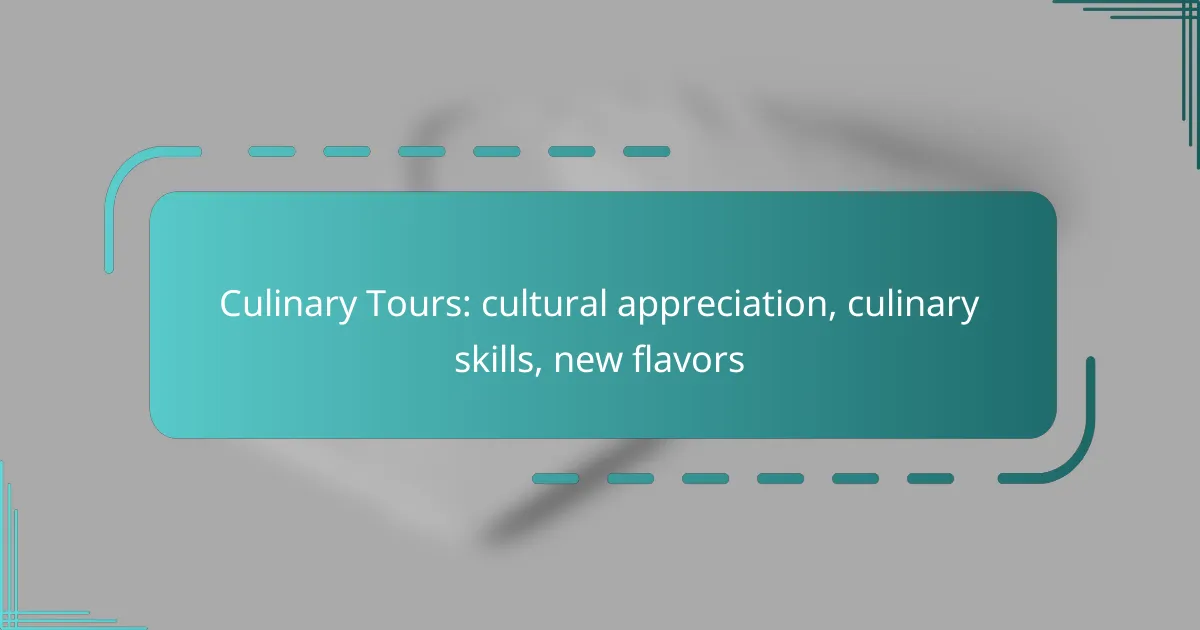Culinary tours provide an enriching blend of cultural appreciation and hands-on cooking experiences, allowing participants to explore new flavors while engaging with local traditions. These immersive journeys connect travelers with expert chefs and unique culinary practices, fostering a deeper understanding of the heritage and values of the communities they visit.

What are the best culinary tours in Europe?
The best culinary tours in Europe offer immersive experiences that blend cultural appreciation with hands-on cooking skills and the exploration of new flavors. These tours typically feature local cuisine, expert chefs, and unique culinary traditions, making them ideal for food enthusiasts and travelers alike.
Gastronomic tours in Italy
Gastronomic tours in Italy are renowned for their focus on regional specialties, from pasta-making in Bologna to truffle hunting in Piedmont. Participants often visit local markets, learn from skilled chefs, and enjoy meals in picturesque settings, enhancing their understanding of Italian culinary heritage.
When choosing a tour, consider the region’s cuisine you wish to explore, as each area has distinct flavors and cooking techniques. Popular options include hands-on cooking classes, wine pairings, and visits to artisanal producers.
Wine and food tours in France
Wine and food tours in France combine the country’s rich viticulture with its diverse culinary landscape. Tours often take place in renowned wine regions like Bordeaux or Burgundy, where participants can taste local wines paired with traditional dishes.
Look for tours that include vineyard visits, wine tastings, and cooking classes focused on French cuisine. Many tours also offer insights into the history and techniques behind French gastronomy, providing a deeper appreciation for the food and wine culture.
Street food tours in Spain
Street food tours in Spain highlight the vibrant and diverse culinary scene found in cities like Barcelona and Madrid. These tours allow participants to sample a variety of local street foods, from tapas to churros, while learning about the cultural significance of each dish.
When participating in a street food tour, be open to trying new flavors and dishes. Look for tours that include visits to popular food markets or local vendors, ensuring an authentic experience that showcases Spain’s culinary creativity.

How can culinary tours enhance cultural appreciation?
Culinary tours significantly enhance cultural appreciation by providing immersive experiences that connect participants with local traditions, ingredients, and cooking techniques. These tours allow travelers to engage directly with the culture through food, fostering a deeper understanding of the community’s heritage and values.
Immersive local experiences
Immersive local experiences on culinary tours often include hands-on cooking classes, market visits, and meals with local families. Participants can learn traditional cooking methods and the stories behind regional dishes, creating lasting memories and connections. For instance, a tour in Italy might involve making pasta from scratch in a local kitchen, guided by a skilled chef.
Additionally, these experiences often highlight the importance of seasonal and local ingredients, allowing travelers to appreciate the flavors unique to the region. Engaging with local producers and artisans can deepen one’s understanding of the cultural significance of food in daily life.
Understanding regional cuisines
Culinary tours provide an opportunity to explore the diversity of regional cuisines, showcasing how geography, climate, and history shape local food practices. Participants can discover the distinct flavors and cooking styles that define a culture, such as the spicy dishes of Southeast Asia or the rich, hearty meals of Eastern Europe.
By tasting various dishes and learning about their origins, travelers can gain insights into the cultural narratives and traditions that influence culinary practices. For example, a tour in Mexico might reveal how indigenous ingredients like corn and chili peppers are integral to the country’s culinary identity.

What culinary skills can you learn on tours?
Culinary tours offer a unique opportunity to learn various cooking skills, from basic techniques to advanced culinary arts. Participants can expect hands-on experiences that enhance their understanding of local cuisines and cooking methods.
Cooking classes with local chefs
Cooking classes led by local chefs are a highlight of many culinary tours. These classes often focus on regional dishes, allowing participants to learn authentic recipes and cooking styles. Expect to spend a few hours in a kitchen setting, where you can practice techniques under the guidance of a professional.
When selecting a cooking class, consider the chef’s expertise and the class size. Smaller groups often provide more personalized attention, enhancing the learning experience. Look for classes that include market visits, as this can deepen your understanding of ingredient selection and local flavors.
Traditional food preparation techniques
Understanding traditional food preparation techniques is essential for appreciating local cuisines. Tours often include demonstrations of methods such as fermentation, smoking, or baking in traditional ovens. These techniques not only enhance flavor but also connect you to the cultural heritage of the region.
To make the most of these experiences, engage actively by asking questions and taking notes. Be open to trying new ingredients and methods, as this will enrich your culinary repertoire. Remember, mastering these techniques may take practice, so consider revisiting them at home to refine your skills.

What new flavors can you discover on culinary tours?
Culinary tours offer a unique opportunity to explore new flavors by immersing yourself in local cuisines and cooking techniques. These experiences often highlight regional specialties, allowing you to taste and learn about ingredients that may be unfamiliar.
Exotic spices in Morocco
Moroccan cuisine is renowned for its bold use of spices, which create complex and aromatic dishes. Common spices include cumin, coriander, saffron, and cinnamon, often blended into spice mixes like ras el hanout. These spices not only enhance flavor but also reflect the country’s rich cultural history.
When on a culinary tour in Morocco, consider visiting local markets to see how these spices are sourced and used. Participating in a cooking class can also provide hands-on experience in using these spices to create traditional dishes like tagine or couscous.
Unique ingredients in Southeast Asia
Southeast Asia is a treasure trove of unique ingredients that contribute to its vibrant culinary landscape. Ingredients like lemongrass, galangal, and kaffir lime leaves are staples in Thai cuisine, while fish sauce and tamarind are essential in Vietnamese cooking. Each ingredient adds distinct flavors that define the region’s dishes.
On a culinary tour, be sure to explore local markets where you can sample fresh herbs, fruits, and vegetables. Engaging with local chefs can provide insights into how to incorporate these ingredients into your cooking, enhancing your culinary skills and appreciation for the flavors of Southeast Asia.

How to choose the right culinary tour?
Choosing the right culinary tour involves identifying your personal interests and evaluating the quality of the tours available. Consider what cuisines excite you and look for tours that emphasize those flavors while also checking reviews to ensure a satisfying experience.
Consider your culinary interests
Your culinary interests should guide your choice of tour. Think about whether you prefer hands-on cooking classes, food tastings, or market visits. For instance, if you enjoy Italian cuisine, seek tours that focus on pasta-making or regional wine pairings.
Additionally, consider dietary restrictions or preferences. If you’re vegetarian or have food allergies, look for tours that cater to these needs, ensuring a more enjoyable and safe experience.
Evaluate tour reviews and ratings
Reading reviews and ratings is crucial for selecting a culinary tour. Check platforms like TripAdvisor or Yelp for feedback from past participants. Look for consistent praise regarding the quality of food, the expertise of guides, and the overall experience.
Pay attention to both positive and negative comments. A few negative reviews can be normal, but if multiple reviews mention the same issues, it may be a red flag. Aim for tours with a high overall rating, ideally above four stars, to increase the likelihood of a satisfying experience.

What are the costs associated with culinary tours?
The costs associated with culinary tours can vary widely based on location, duration, and inclusions. Generally, participants should expect to spend anywhere from a few hundred to several thousand dollars, depending on the experience offered.
Average pricing for tours in Italy
Culinary tours in Italy typically range from around €100 to €300 per person for a half-day experience, which often includes cooking classes, tastings, and guided market visits. Full-day tours can cost between €200 and €600, especially if they include multiple meals and transportation.
When choosing a tour, consider what is included in the price. Some tours may offer exclusive experiences, such as private chef interactions or visits to renowned wineries, which can justify higher costs. Always check reviews to ensure the value matches the price.
Budget-friendly options in Thailand
In Thailand, culinary tours can be quite affordable, with prices starting as low as 1,500 THB (approximately $45) for a half-day cooking class. These budget-friendly options often include a market tour and a hands-on cooking session, making them accessible for travelers on a budget.
To find the best deals, look for local cooking schools or community-run classes, which often provide authentic experiences at lower prices. Booking in advance or during off-peak seasons can also lead to significant savings.

What are the benefits of culinary tours?
Culinary tours offer a unique opportunity to explore new flavors, enhance culinary skills, and appreciate diverse cultures through food. Participants gain hands-on experience while learning about local ingredients, cooking techniques, and traditional dishes.
Cultural appreciation
Culinary tours immerse participants in the local culture, allowing them to understand the historical and social significance of various cuisines. Engaging with local chefs and food artisans provides insights into regional customs and traditions that shape culinary practices.
For example, a tour in Italy might include visits to family-owned vineyards and olive oil mills, where travelers can learn about the heritage behind these products. This deepens appreciation for the food and its origins, fostering a connection to the culture.
Culinary skills
On culinary tours, participants often engage in hands-on cooking classes that enhance their culinary skills. These classes typically cover essential techniques, from knife skills to mastering specific cooking methods, tailored to the local cuisine.
For instance, a tour in Thailand may include a session on preparing traditional dishes like Pad Thai or Green Curry, where participants learn to balance flavors and use local ingredients effectively. This practical experience can significantly boost confidence in the kitchen.
New flavors
Culinary tours expose travelers to a variety of flavors that they may not encounter at home. This exploration of local ingredients and dishes broadens palates and inspires creativity in home cooking.
For example, a tour in Mexico can introduce participants to unique spices and fresh produce, such as tomatillos and epazote, which can transform their cooking. Trying these new flavors encourages experimentation and can lead to a more adventurous approach to meal preparation.
